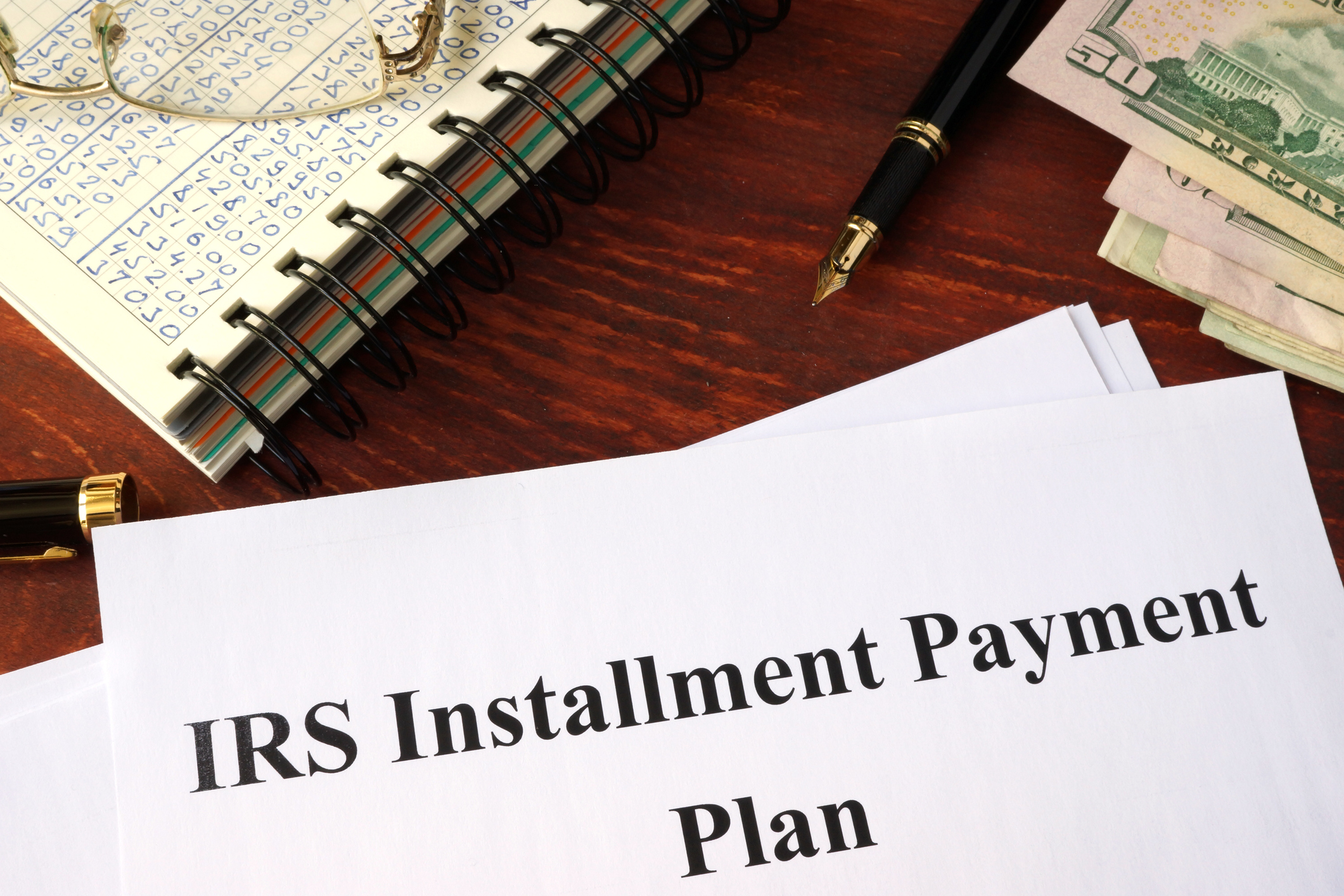If you owe the IRS and can’t pay in full, you’re not out of options—you’re at a decision point. The IRS offers monthly payment plans called Installment Agreements that can stop aggressive collections, spread payments over time, and give you space to breathe again.
An Installment Agreement is one of the most commonly used programs to resolve unpaid taxes, but there are several types to choose from. To ensure you get the best IRS payment plan for you, it’s important to read through each type and pick the one that best suits your needs.
This guide breaks down every major IRS payment plan, walking you through the pros and cons, costs, lien risk, and common pitfalls to avoid. By the end, you’ll know which path fits your financial situation—and be able to confidently choose the best IRS Installment Agreement for you.
💡 Payment Plan: Quick Picker
- Can you fully pay within ~6 months? → Short-Term Payment Plan (no setup fee)
- Owe $10,000 or less, with a clean history, and can finish in 36 months? → Guaranteed Installment Agreement
- Owe $50,000 or less and need up to 72 months? → Streamlined Installment Agreement
- Owe up to $50,000 and want a simpler path—often up to the full collection period? → Simple Payment Plan
- Owe more than $50,000 or need lower payments than streamlined allows? → Regular (Non-Streamlined) Agreement
- Can’t afford to ever full-pay before the collection clock runs out? → Partial Payment Installment Agreement
- Tip: Direct debit (automatic bank withdrawals) typically lowers setup fees and helps prevent defaults.
If you’re reading this article, you already know that an installment agreement is one of the tax relief options offered by the IRS Fresh Start Program.
When you accumulate tax debt, sometimes the full amount is more than you can pay all at once. An IRS installment agreement allows you to pay your balance in monthly payments instead of one lump sum. While you’re on a plan and stay current, the IRS typically won’t garnish or levy you. Interest and the failure-to-pay penalty still accrue until the balance is paid, but you gain some security and protection from IRS collection actions.
How Do I Get Approved for an IRS Installment Agreement?
To get your installment agreement approved by the IRS, you first need to file any missing tax returns you may have. Once complete, you will know exactly how much you owe and can explore payment plan options.
Most people with balances of $50,000 or less can apply online in minutes with minimal paperwork. You can also request a plan by mail or phone if you prefer. Follow the steps below to maximize your chance of approval:
-
Get compliant first: Track down and file any missing returns—required before the IRS will approve a plan.
-
Build a payment you can keep: Shape a monthly amount that fits both IRS rules and your real cash flow, and choose a due date/direct debit setup that prevents missteps.
-
Compare every path: Evaluate whether a Partial Payment Installment Agreement, short-term plan, non-streamlined option, or even an Offer in Compromise better serves your goals.
-
Present airtight financials: Prepare the Form 433 series and document allowable expenses correctly to avoid delays, denials, and unnecessary lien risk.
-
Reduce total cost where possible: Pursue penalty relief, low-income fee waivers (when eligible), and smart tactics like paying down to key thresholds to lower fees and speed approval.
The IRS bases your payment on your total back taxes, income, and “allowable” expenses tied to national and local standards. If you propose a number that’s too low, expect a request for full financials—or a denial. For complete instructions on applying for an IRS payment plan, read How to Set Up an IRS Payment Plan: Form 9465 Instructions.
If you’re struggling with this process, you don’t have to go through it alone. As a professional tax relief company, TaxRise can ensure all of your tax returns are correctly filed. Additionally, we offer a free tax consultation that will help determine which tax relief program will work best for your unique situation.
Will The IRS Be Able To Garnish Wages Or Seize My Assets?
Once you’re in an installment agreement with the IRS, then no, the IRS can’t typically seize your assets in order to pay off your tax debt. Viewed as a formal resolution, installment agreements show that you’re making the effort to reduce your tax debt.
Installment Agreements: The 7 Different Types And Which Is Best For You
As you can see, the IRS offers several options when it comes to installment agreements. Though there are different installment agreement types, they have more in common than they have differences.
The thing each installment plan has in common is that interest still accumulates — so paying off the debt as fast as possible will save you money later.
1. Short-Term Payment Plan (up to 180 days)
This option fits taxpayers who can pull funds together quickly and want a no-friction way to resolve the balance. You get up to 180 days to pay the full amount, there’s no setup fee, and approval is typically fast through the IRS website or by phone—without any financial disclosure. The tradeoff is that interest and the failure-to-pay penalty continue while you’re on the plan, and if your cash doesn’t arrive as expected, you won’t have long-term protection from collections once the 180 days end.
Pros
- $0 setup fee
- No financial disclosure
- Fast approval online
Cons
- Interest/penalties continue until paid
- No long-term protection if you can’t finish in time
When to choose it
You’re waiting on a bonus, sale of an asset, or short-term cash infusion.
2. Guaranteed Installment Agreement (≤ $10,000; up to 36 months)
If your balance is relatively small and your filing history is clean, the guaranteed agreement delivers a straightforward path. When you owe $10,000 or less (tax only), have filed all required returns, haven’t had an installment agreement in the last five years, and can pay off the balance within 36 months—or before the collection statute ends—the IRS must approve your plan. You won’t need to provide detailed financials, and setup is simple. The downside is the shorter payoff window compared to other plans and, as always, ongoing interest and penalties until the final payment is made.
Pros
- Guaranteed approval when criteria are met
- No financial disclosure
- Straightforward setup
Cons
- Shorter payoff window than other plans
- Interest/penalties still accrue
Watch out for: New balances during the plan can default the agreement—stay current going forward.
3. Streamlined Installment Agreement (SLIA) (≤ $50,000; up to 72 months)
For many people, the streamlined agreement is the “just right” option: balances of $50,000 or less can be spread over as long as 72 months (or until the collection statute expires), and you typically avoid revenue-officer scrutiny and the heavy paperwork of a financial disclosure. It’s fast to set up online and predictable in monthly amounts. However, if the 72-month math still produces a payment you can’t afford, you’ll likely need to graduate to a non-streamlined plan with financials, and a federal tax lien is still possible—especially on higher balances.
Pros
- No detailed financial disclosure
- Usually no revenue officer involvement
- Fast online approval
Cons
- If you need a lower monthly payment than 72-month math allows, you’ll likely be pushed to a non-streamlined plan with financials
- A Notice of Federal Tax Lien is still possible, especially at higher balances
Fee & payment tips
-
Direct debit typically has a lower setup fee and reduces default risk. Low-income applicants may qualify for reduced/waived fees via Form 13844.
-
If your balance is just over $50,000, consider a small upfront payment to get below the SLIA threshold.
4. Simple Payment Plans
Simple Payment Plans were designed to make life easier for the vast majority of individual taxpayers who owe $50,000 or less. They work like a streamlined agreement with an even lighter touch: no financial disclosure, broad eligibility, and easy setup online or with an IRS employee. In many cases, these plans can run to the end of the collection statute rather than stopping at 72 months, giving you more flexibility. You’ll still accrue interest and penalties along the way, and your exact term may hinge on how much time remains on the IRS collection clock, but the entry process is about as simple as it gets.
Pros
- No financial disclosure
- Broad eligibility and simple setup
- Often allows repayment over the remaining collection statute (not just 72 months)
Cons
- Still accrues interest/penalty
- Terms can vary based on your statute timeline (the IRS generally has 10 years to collect)
5. Regular Installment Agreement (Non-Streamlined)
When balances exceed $50,000—or when you need a payment lower than streamlined rules allow—the non-streamlined agreement becomes the workhorse. You’ll complete a Collection Information Statement (Form 433 series), and the IRS will evaluate your income, necessary living expenses (using national and local standards), and assets to determine an affordable payment. Because the plan is tailored to your real cash flow, it can stretch to the end of the collection statute. The tradeoffs are added time and effort, a higher likelihood of a federal tax lien, and potential requests to liquidate or borrow against certain assets before approval.
When applying for a Regular Installment Agreement, it’s critical to prepare financials carefully. Presenting allowable expenses correctly can meaningfully reduce the monthly amount.
Pros
- Tailored to your actual ability to pay
- Can run for the remaining collection statute (up to ~10 years)
Cons
- Financial disclosure required (time-consuming)
- Possible asset liquidation requests or expense limits
6. Partial Payment Installment Agreement (PPIA)
A PPIA is built for true hardship—situations where, even with a long runway, you won’t be able to fully pay the balance before the collection statute expires. You’ll submit detailed financials, and the IRS sets a monthly amount that reflects your actual ability to pay. You continue making payments until the collection period ends, at which point any remaining balance becomes uncollectible. Expect a more documentation-heavy process, periodic two-year reviews that can adjust your payment if your finances improve, and a strong likelihood of a tax lien. In return, you gain the lowest sustainable monthly payment and a realistic path forward when full payment simply isn’t possible.
If you are experiencing a significant financial hardship and don’t expect to ever be able to repay your tax debt, also look into the Offer in Compromise program, which can settle your liability for less than the full amount owed.
Pros
- Lowest sustainable monthly payments
- You may pay less than the full balance over time
Cons
- Most documentation-heavy option; periodic reviews
- Lien is likely
- Not a quick fix—still requires strict compliance
When to choose it
You’ve explored Offer in Compromise but don’t qualify, and a standard plan isn’t affordable.
Not sure if an Installment Agreement is right for you? Explore qualifying for other resolution options in our Guide to Fresh Start Program Requirements.
7) Direct Debit Installment Agreement (DDIA)
An IRS Direct Debit Installment Agreement is the “set it and forget it” version of a payment plan: your monthly amount is pulled automatically from your checking or savings account on the date you choose. It’s a strong fit if you want the lowest setup fee, the best odds of staying in good standing, and—at certain balance levels—the option the IRS prefers or may even require.
The big advantages are consistency and protection: automatic drafts dramatically reduce missed payments (a common cause of default), and choosing direct debit can sometimes weigh in your favor when the IRS considers lien action. The tradeoffs are mostly about logistics. You’ll need a stable bank account with funds available on draft day, and any insufficient-funds hiccup can cause fees, extra notices, or even a plan default if not fixed quickly. If you change banks, you must update your authorization before the next draft, and you’ll still want to monitor payments so nothing slips through the cracks.
When to choose it
You want the lowest fees and the highest chance of staying in good standing—or your balance is high enough that the IRS will insist on automatic payments.
Good to know
You control the draft date, and in many cases consistent on-time direct debits can strengthen later requests—like adjusting your payment amount or asking the IRS to reconsider lien action after your balance drops.
Pro move
Schedule the draft a few days after payday, keep a small cushion in your account, and—if you’re near a threshold for a simpler plan—make a one-time payment to qualify, then lock in the DDIA for lower fees and smoother approval.
💡 How to estimate a monthly payment that actually works
- Quick math: Balance ÷ 72 ≈ a ballpark SLIA payment. If that’s too high, you may need a non-streamlined or PPIA route.
- Cash-flow test: Can you comfortably make the payment for the next 12 months—even if an unexpected bill pops up? If not, rethink your plan type.

Installment Agreement Costs and Fees
Apply online (fastest): The IRS Online Payment Agreement tool is usually the quickest way to set up a plan, with many applicants getting an immediate decision. If online isn’t an option, you can apply by mail or phone using Form 9465—and if your balance is higher or the IRS requests it, be ready to include financials.
Setup fees:
-
Short-term plan: $0 setup—though interest and the late-payment penalty keep running until you’re paid in full.
-
Long-term, direct debit: Typically the lowest setup fee compared to other payment methods.
-
Low-income relief: Many fees can be reduced, waived, or even reimbursed when you qualify and submit Form 13844.
Exact dollar amounts change from time to time, so it’s smart to check the IRS website for the latest fees and application details.
Payment methods:
-
Direct debit (preferred for simplicity and fewer missed-payment issues)
-
Direct Pay/EFTPS (ACH bank transfers)
-
Check or money order
-
Debit/credit card (note that third-party processors charge a separate fee)
Tax Liens, Defaults, and Pitfalls
A quick reality check on liens: the IRS can file a Notice of Federal Tax Lien, and it’s more likely when balances are higher or you’re on a non-streamlined plan. Getting your agreement set up early and using direct debit can reduce the odds, but there isn’t a guaranteed “safe harbor” that makes liens impossible. Think of those steps as smart risk-reducers—not absolutes.
Defaults are the other big pitfall. An agreement can fall apart if you miss an IRS payment, file a return late, or add new unpaid tax while you’re still paying off the old balance. If you see a cash-flow crunch coming, act before the due date: move your draft date, request a lower payment, or switch to direct debit so the payment pulls automatically.
Changing your existing payment plan is possible, although there are potential pitfalls involved. A small tweak now beats a default later. To learn more about changing your existing plan, read Change Your IRS Payment Plan: How to Revise, Lower, or Cancel Your Monthly Payments.
Finally, remember the collection clock—the Collection Statute Expiration Date (CSED). Most agreements are built to fully pay your balance before that clock runs out. Two notable exceptions are Partial Payment Installment Agreements and many Simple Payment Plans, which are designed to run to the statute. Knowing where you stand on that timeline helps you pick the right plan and avoid surprises.
The Takeaway
If you don’t know which Fresh Start Program or installment plan best suits your needs, check out TaxRise’s free tax consultation. From this quick call, you’ll be able to determine if you qualify for our services and which tax relief program will work best for your unique situation.
TaxRise advocates on your behalf for the best possible tax relief outcome. We have helped thousands of taxpayers just like you resolve their tax issues and erase their tax liability. Take our quick survey to discover if you may qualify for tax relief programs and learn more about how to choose the best type of IRS Installment Agreement for you.





0 Comments